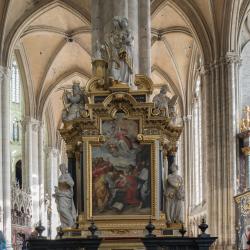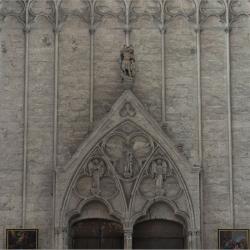South transept, looking east
Here you can see across the south transept down into the inner aisle of the choir: in the distance this aisle begins to turn into the eastern ambulatory with its radiating chapels. The transept arcade, directy across from us, has three arches (the outermost one to the right invisible here): the arches get progressively wider towards the crossing, producing a very wide span directly in front of us. The great weight of this arch has forced the crossing pier to buckle inwards, allowing alarming cracks to open in the masonry. Also at play is the westward thrust of the transverse arches of the aisle vaults: the intermediary piers dividing the aisle were charged with the enormous weight of uprights for the flying buttresses.
It was in the upper eastern sides of the transept arms that the young master mason called Renaud de Cormont began to experiment with new forms: you can see that the triforium is now open and glazed, admitting much light.
The chapel to the east side of the south transept (with the partially-blocked window on the right) was the first chapel to be completed: in 1233 the former dean, Jean d'Abbeville, founded a chapel dedicated to the Conversion of Saint Paul. Set against the pier directly across from us you can see the altar of Puy Notre Dame. This altar served as a chapel for the important lay confraternity of Puy Notre Dame established in the 14th century. The south transept served as headquarters for this confraternity: the names of the masters are engraved on black marble plaques affixed to the lower west wall of the transept. You can find the name of Adrien de Hénencourt (later dean) under the year 1492.
The altar of Notre-Dame du Puy was commissioned in 1627 by Antoine Pingre, master of the confraternity. The sculpture was done by Nicolas Blasset:above, the virgin rescues a child from a well; she is flanked by David and Solomon. Bellow, Geneviève and Judith with the head of Holophernes. The painting of the Assumption by Francken the Younger (1628).
The south transept with its sumptuous portal also served as ceremonial corridor for processions of the clergy: this role is marked by the presence of angels in the architecture of the inner portal and angels in the upper rose window.


